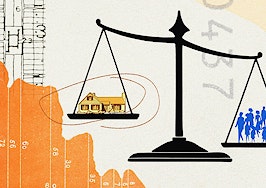- The average estimated home value across 1,661 ZIPs with at least one good school was $427,402
- The average home value in ZIPs that lack high-performing elementary schools is of $241,096.
- Median home prices in ZIP codes with good schools are up 4.5 percent compared to the same period in 2006.
- The overwhelming majority (83 percent) of metros showed stronger home values near highly-ranked elementary schools.
Real estate agents can agree that high-performing school districts make for good home investment locations.
Many homebuyers figure good schools make for stronger demand at resale, and Attom Data Solutions’ Schools and Housing Report shows that ZIP codes with at least one good elementary school truly do hold higher home values.
The average estimated home value across 1,661 ZIPs with at least one good school was $427,402 — or 77 percent higher than the average home value of $241,096 in the remaining ZIPs that lack high-performing elementary schools.

“Intuitively, buyers already know that schools are important when buying a home, even if they don’t have school-aged children. It’s a nice amenity to have for quality of life,” said Daren Blomquist, senior vice president at Attom.
“But this data proves that there is a tangible financial impact that good schools have on home values and home price appreciation over time.”
In order to school rankings and nearby home values, Attom considered good schools to hold test scores 33 percent higher than the statewide average.
Compared to 2006, year-to-date median home price in ZIP codes without good schools is 1 percent less. But, median home prices in ZIP codes with good schools are up 4.5 percent compared to the same period in 2006.

Between 2006 and 2011, median home prices in ZIPs without good schools dropped an average 28.9 percent, compared to a 23 percent decline in ZIPs with at least one good school.
Buying in a big city? Search for good school districts
The overwhelming majority (83 percent) of metros showed stronger home values near highly-ranked elementary schools.
In Los Angeles and Chicago, ZIP codes with good schools were valued 65 percent higher compared to those without.
New York City homes close to good schools are valued 52 percent higher, on average. In Miami, homes near good schools are 31 percent more expensive.
In Baltimore, homes in ZIPs near good schools were 95 percent higher.
ROI typically stronger near good schools
Since purchase, homeowners near good schools have gained an average of $74,716, or a 32 percent return on investment (ROI). The average ROI for homes farther from highly rated schools is 27.5 percent, or $23,311.
Homeowner ROI in ZIP codes with at least one good school was 3.1 percent higher in San Francisco and 6 percent stronger in New York. In Miami and Chicago, good school ZIP code ROI was 6.7 and 5.9 percent higher, respectively.
In the Houston metro area, the difference in ROI was a staggering 773.9 percent — favoring the good school ZIPs.
On the other hand, Los Angeles and Washington, D.C., showed stronger ROI in ZIP codes without at least one highly-rated school. In both metros, ROI was 4.2 percent higher in ZIPs outside of the good school district.
Blomquist says in these metros specifically, home prices may be lower in ZIP codes without a good school, but those areas are in higher demand right now. Affordability has somewhat outweighed the school affect in certain metros.
“An interesting caveat is that there’s a point where people can place too much importance on schools,” Blomquist said. “They don’t completely make or break your real estate investment as a homeowner, and I think those two metro areas prove that it’s not the only factor that can increase or decrease value.”

Attom also ranked the top 10 ZIPs near good schools with median sales prices under $150,000.
Two ZIPs in Chicago made the good school bargains list (60620, 60645), along with 33712 in St. Petersburg, Florida, and 32835 in Orlando, Florida.
“Good schools and higher prices don’t always go hand-in-hand,” he said. “There are instances where you can find good schools in a lower priced market, but those are exceptions and not the rule.”












